engine FIAT PANDA 2014 319 / 3.G Owner's Guide
[x] Cancel search | Manufacturer: FIAT, Model Year: 2014, Model line: PANDA, Model: FIAT PANDA 2014 319 / 3.GPages: 284, PDF Size: 11.54 MB
Page 98 of 284

RADIO TRANSMITTERS AND MOBILE
PHONES
Radio transmitter equipment (vehicle mobile phones,
CB radios, amateur radio, etc.) cannot be used
inside the car unless a separate aerial is mounted
externally.
IMPORTANT The use of these devices inside the
passenger compartment (without an external aerial)
may cause the electrical systems to malfunction.
This could compromise the safety of the car in
addition to constituting a potential hazard for
passengers' health.
In addition, transmission and reception of these
devices may be negatively affected by the shielding
effect of the car body. As far as the use of
EC-approved mobile phones is concerned (GSM,
GPRS, UMTS), follow the usage instructions provided
by the mobile phone manufacturer.
REFUELLING THE CARVersions equipped with "Smart Fuel" system are
provided with an inhibiter which prevents refuelling
with incorrect fuel.
Accidental refuelling with non-compliant fuels (e.g.
petrol in Diesel engines) can only occur in the case
of versions equipped with fuel tank cap. Before
refuelling, make sure that the fuel type is correct.
Stop the engine before refuelling.
PETROL ENGINES
Use unleaded petrol only, with an octane number
(R.O.N.) no lower than 95. In order to prevent
damage to the catalytic converter never introduce
even the smallest amount of leaded petrol, even
in the event of an emergency.
IMPORTANT An inefficient catalytic converter leads
to harmful exhaust emissions, thus contributing to
air pollution.
IMPORTANT Never use leaded petrol, even in small
amounts or in an emergency, as this would damage
the catalytic converter beyond repair.
DIESEL ENGINES
Operation at low temperatures
If the outside temperature is very low, the diesel
thickens due to the formation of paraffin clots with
consequent defective operation of the fuel supply
system.
94GETTING TO
KNOW YOUR CAR
SAFETY
STARTING AND
DRIVING
WARNING LIGHTS
AND MESSAGES
IN AN EMERGENCY
SERVICING AND
MAINTENANCE
TECHNICAL
SPECIFICATIONS
INDEX
Page 99 of 284
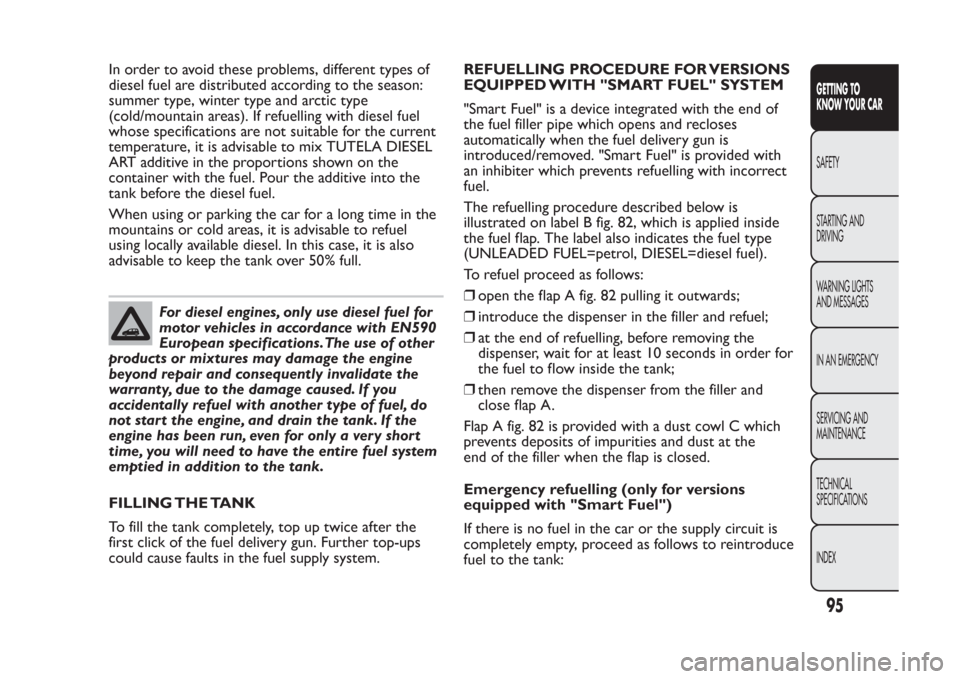
In order to avoid these problems, different types of
diesel fuel are distributed according to the season:
summer type, winter type and arctic type
(cold/mountain areas). If refuelling with diesel fuel
whose specifications are not suitable for the current
temperature, it is advisable to mix TUTELA DIESEL
ART additive in the proportions shown on the
container with the fuel. Pour the additive into the
tank before the diesel fuel.
When using or parking the car for a long time in the
mountains or cold areas, it is advisable to refuel
using locally available diesel. In this case, it is also
advisable to keep the tank over 50% full.
For diesel engines, only use diesel fuel for
motor vehicles in accordance with EN590
European specifications.The use of other
products or mixtures may damage the engine
beyond repair and consequently invalidate the
warranty, due to the damage caused. If you
accidentally refuel with another type of fuel, do
not start the engine, and drain the tank. If the
engine has been run, even for only a very short
time, you will need to have the entire fuel system
emptied in addition to the tank.
FILLING THE TANK
To fill the tank completely, top up twice after the
first click of the fuel delivery gun. Further top-ups
could cause faults in the fuel supply system.REFUELLING PROCEDURE FOR VERSIONS
EQUIPPED WITH "SMART FUEL" SYSTEM
"Smart Fuel" is a device integrated with the end of
the fuel filler pipe which opens and recloses
automatically when the fuel delivery gun is
introduced/removed. "Smart Fuel" is provided with
an inhibiter which prevents refuelling with incorrect
fuel.
The refuelling procedure described below is
illustrated on label B fig. 82, which is applied inside
the fuel flap. The label also indicates the fuel type
(UNLEADED FUEL=petrol, DIESEL=diesel fuel).
To refuel proceed as follows:
❒open the flap A fig. 82 pulling it outwards;
❒introduce the dispenser in the filler and refuel;
❒at the end of refuelling, before removing the
dispenser, wait for at least 10 seconds in order for
the fuel to flow inside the tank;
❒then remove the dispenser from the filler and
close flap A.
Flap A fig. 82 is provided with a dust cowl C which
prevents deposits of impurities and dust at the
end of the filler when the flap is closed.
Emergency refuelling (only for versions
equipped with "Smart Fuel")
If there is no fuel in the car or the supply circuit is
completely empty, proceed as follows to reintroduce
fuel to the tank:
95GETTING TO
KNOW YOUR CARSAFETY
STARTING AND
DRIVING
WARNING LIGHTS
AND MESSAGES
IN AN EMERGENCY
SERVICING AND
MAINTENANCE
TECHNICAL
SPECIFICATIONS
INDEX
Page 102 of 284
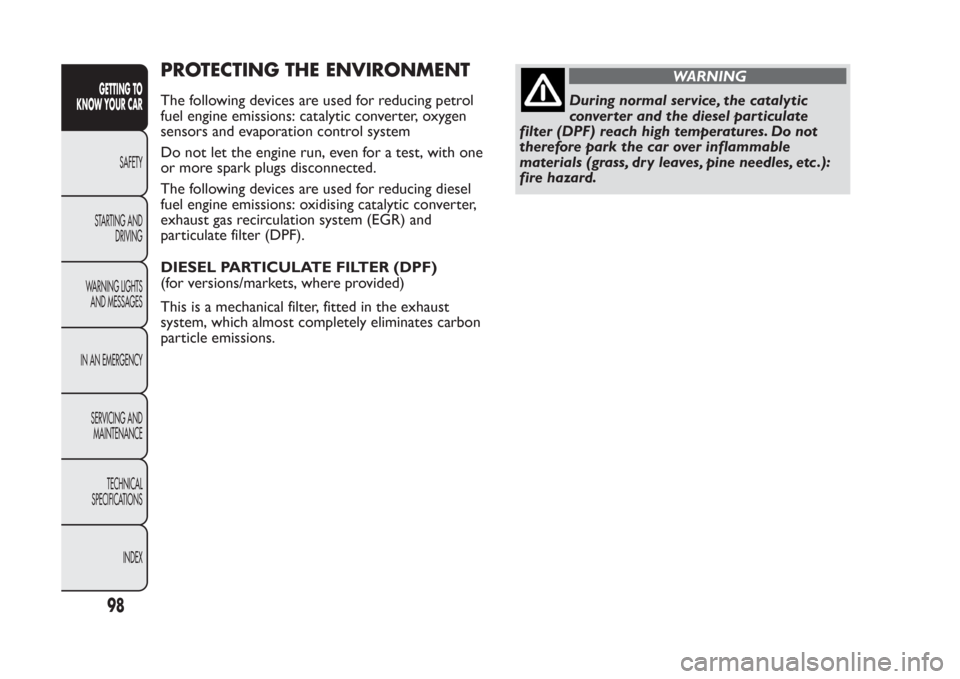
PROTECTING THE ENVIRONMENTThe following devices are used for reducing petrol
fuel engine emissions: catalytic converter, oxygen
sensors and evaporation control system
Do not let the engine run, even for a test, with one
or more spark plugs disconnected.
The following devices are used for reducing diesel
fuel engine emissions: oxidising catalytic converter,
exhaust gas recirculation system (EGR) and
particulate filter (DPF).
DIESEL PARTICULATE FILTER (DPF)
(for versions/markets, where provided)
This is a mechanical filter, fitted in the exhaust
system, which almost completely eliminates carbon
particle emissions.
WARNING
During normal service, the catalytic
converter and the diesel particulate
filter (DPF) reach high temperatures. Do not
therefore park the car over inflammable
materials (grass, dry leaves, pine needles, etc .):
fire hazard.
98GETTING TO
KNOW YOUR CAR
SAFETY
STARTING AND
DRIVING
WARNING LIGHTS
AND MESSAGES
IN AN EMERGENCY
SERVICING AND
MAINTENANCE
TECHNICAL
SPECIFICATIONS
INDEX
Page 124 of 284

WARNING
If the key is inser ted and turned to MAR
when no faults are indicated by the
warning lights, air bags may be deployed if
another vehicle crashes into the vehicle even if
the engine is not running and the vehicle is
stationary. For this reason, children must never
occupy the front seat , even if the car is not
moving. On the other hand, if the key is inser ted
in STOP position, none of the safety devices
(air bags or pretensioners) will be deployed in
the event of impact . Non-deployment of these
devices does not indicate a system malfunction.
WARNING
For versions/markets where provided,
when the ignition key is turned to MAR,
the “yellow”
warning light switches on for a
few seconds. If the passenger air bag/side bag is
active, the “yellow” warning light switches off
after a few seconds. If the passenger air bag/side
bag is NOT active, the “yellow” warning light
stays on.
WARNING
The air bag deployment threshold is
higher than that of the pretensioners.
For collisions in the range between the two
thresholds, it is normal for only the
pretensioners to be activated.
WARNING
The air bag does not replace seat belts
but increases their effectiveness.
Because front air bags are not deployed for
low-speed crashes, side collisions, rear-end
shunts or rollovers, occupants are protected, in
addition to any side bags, only by their seat
belts, which must therefore always be fastened.
WARNING
If the “red”
warning light does not
switch on for a few seconds when the
key is turned to MAR, there may be a fault with
the “red” warning light . In this case, the
“yellow” warning light star ts to flash after a few
seconds and, for versions/markets where
provided, the explosive charges of the passenger
air bag and the side bag are deactivated. Before
continuing, contact a Fiat Dealership
immediately to have the system checked.
120
GETTING TO KNOW
YOUR CAR
SAFETY
STARTING AND
DRIVING
WARNING LIGHTS
AND MESSAGES
IN AN EMERGENCY
SERVICING AND
MAINTENANCE
TECHNICAL
SPECIFICATIONS
INDEX
Page 125 of 284
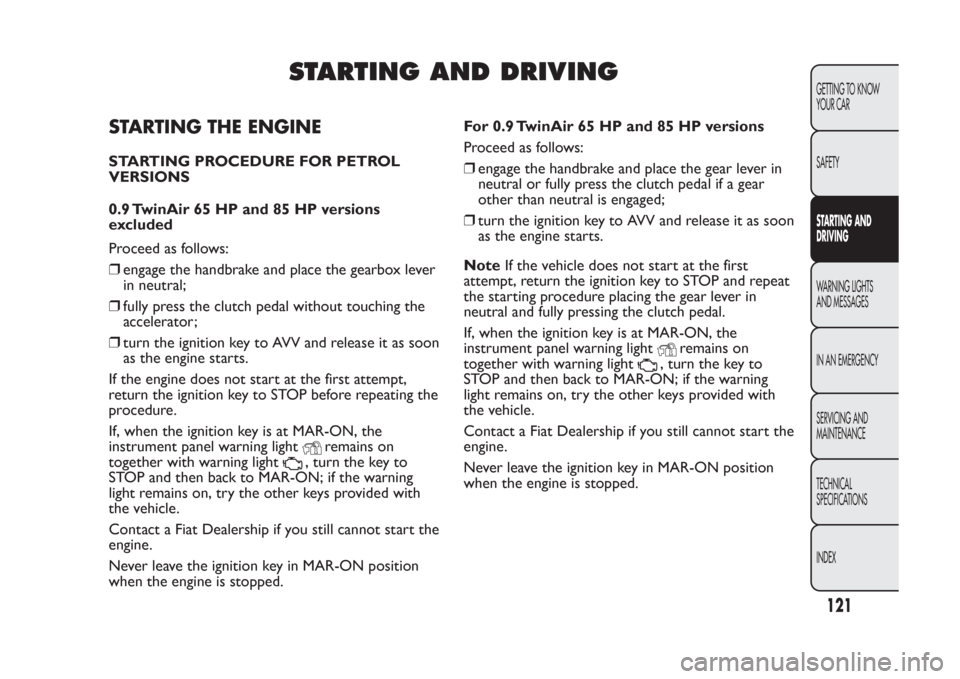
STARTING AND DRIVING
STARTING THE ENGINESTARTING PROCEDURE FOR PETROL
VERSIONS
0.9 TwinAir 65 HP and 85 HP versions
excluded
Proceed as follows:
❒engage the handbrake and place the gearbox lever
in neutral;
❒fully press the clutch pedal without touching the
accelerator;
❒turn the ignition key to AVV and release it as soon
as the engine starts.
If the engine does not start at the first attempt,
return the ignition key to STOP before repeating the
procedure.
If, when the ignition key is at MAR-ON, the
instrument panel warning light
remains on
together with warning light
, turn the key to
STOP and then back to MAR-ON; if the warning
light remains on, try the other keys provided with
the vehicle.
Contact a Fiat Dealership if you still cannot start the
engine.
Never leave the ignition key in MAR-ON position
when the engine is stopped.For 0.9 TwinAir 65 HP and 85 HP versions
Proceed as follows:
❒engage the handbrake and place the gear lever in
neutral or fully press the clutch pedal if a gear
other than neutral is engaged;
❒turn the ignition key to AVV and release it as soon
as the engine starts.
NoteIf the vehicle does not start at the first
attempt, return the ignition key to STOP and repeat
the starting procedure placing the gear lever in
neutral and fully pressing the clutch pedal.
If, when the ignition key is at MAR-ON, the
instrument panel warning light
remains on
together with warning light
, turn the key to
STOP and then back to MAR-ON; if the warning
light remains on, try the other keys provided with
the vehicle.
Contact a Fiat Dealership if you still cannot start the
engine.
Never leave the ignition key in MAR-ON position
when the engine is stopped.
121GETTING TO KNOW
YOUR CAR
SAFETYSTARTING AND
DRIVINGWARNING LIGHTS
AND MESSAGES
IN AN EMERGENCY
SERVICING AND
MAINTENANCE
TECHNICAL
SPECIFICATIONS
INDEX
Page 126 of 284
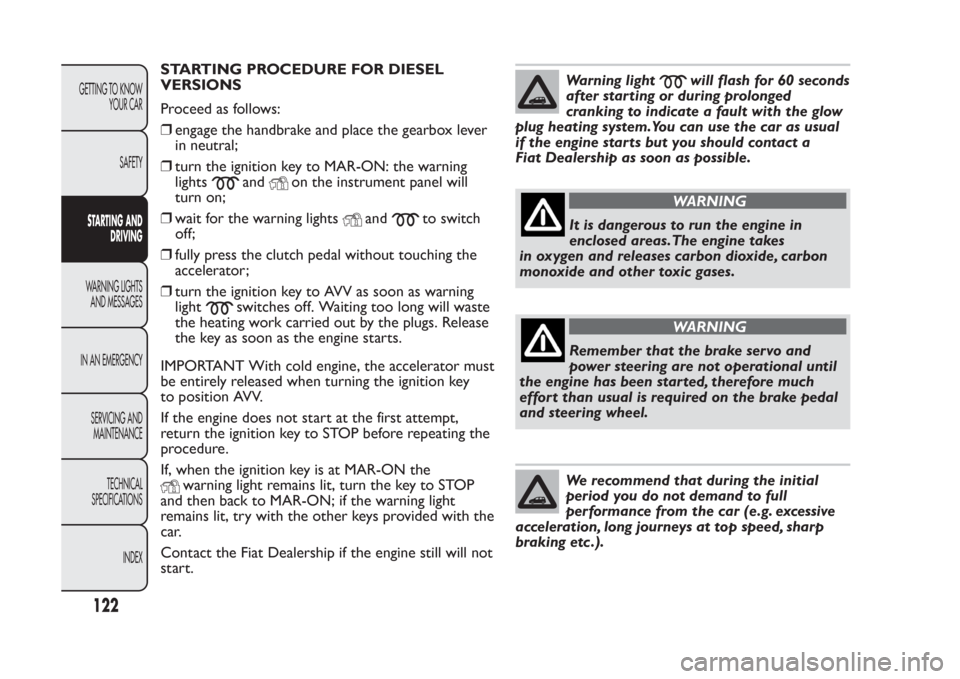
STARTING PROCEDURE FOR DIESEL
VERSIONS
Proceed as follows:
❒engage the handbrake and place the gearbox lever
in neutral;
❒turn the ignition key to MAR-ON: the warning
lights
and
on the instrument panel will
turn on;
❒wait for the warning lights
and
to switch
off;
❒fully press the clutch pedal without touching the
accelerator;
❒turn the ignition key to AVV as soon as warning
light
switches off. Waiting too long will waste
the heating work carried out by the plugs. Release
the key as soon as the engine starts.
IMPORTANT With cold engine, the accelerator must
be entirely released when turning the ignition key
to position AVV.
If the engine does not start at the first attempt,
return the ignition key to STOP before repeating the
procedure.
If, when the ignition key is at MAR-ON the
warning light remains lit, turn the key to STOP
and then back to MAR-ON; if the warning light
remains lit, try with the other keys provided with the
car.
Contact the Fiat Dealership if the engine still will not
start.
Warning light
will flash for 60 seconds
after starting or during prolonged
cranking to indicate a fault with the glow
plug heating system.You can use the car as usual
if the engine starts but you should contact a
Fiat Dealership as soon as possible.
WARNING
It is dangerous to run the engine in
enclosed areas.The engine takes
in oxygen and releases carbon dioxide, carbon
monoxide and other toxic gases.
WARNING
Remember that the brake servo and
power steering are not operational until
the engine has been started, therefore much
effort than usual is required on the brake pedal
and steering wheel.We recommend that during the initial
period you do not demand to full
performance from the car (e.g. excessive
acceleration, long journeys at top speed, sharp
braking etc .).
122
GETTING TO KNOW
YOUR CAR
SAFETYSTARTING AND
DRIVINGWARNING LIGHTS
AND MESSAGES
IN AN EMERGENCY
SERVICING AND
MAINTENANCE
TECHNICAL
SPECIFICATIONS
INDEX
Page 127 of 284
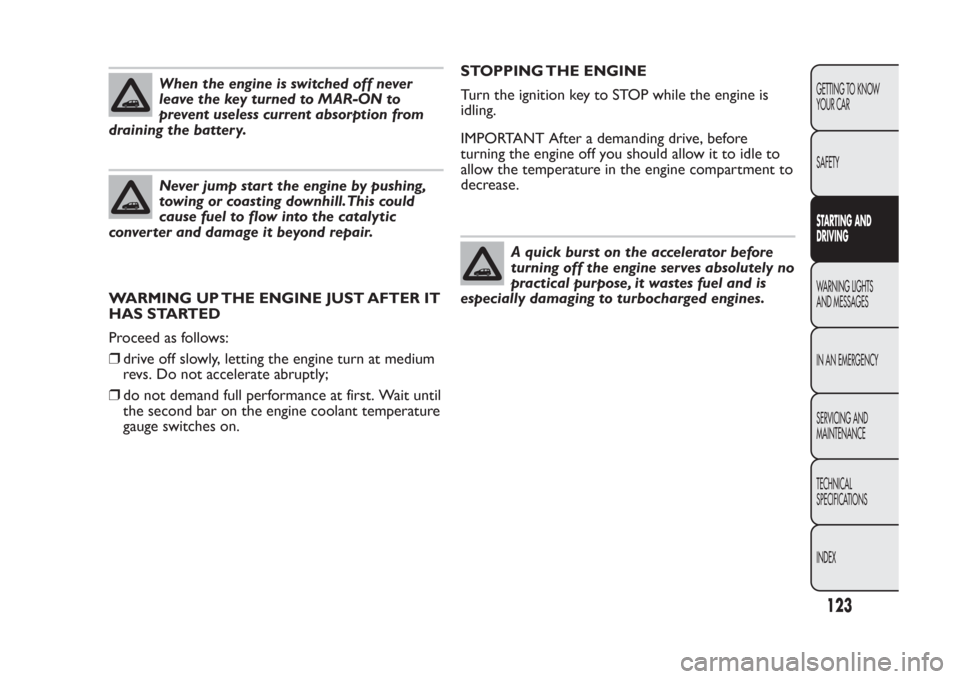
When the engine is switched off never
leave the key turned to MAR-ON to
prevent useless current absorption from
draining the battery.Never jump start the engine by pushing,
towing or coasting downhill.This could
cause fuel to flow into the catalytic
conver ter and damage it beyond repair.
WARMING UP THE ENGINE JUST AFTER IT
HAS STARTED
Proceed as follows:
❒drive off slowly, letting the engine turn at medium
revs. Do not accelerate abruptly;
❒do not demand full performance at first. Wait until
the second bar on the engine coolant temperature
gauge switches on.STOPPING THE ENGINE
Turn the ignition key to STOP while the engine is
idling.
IMPORTANT After a demanding drive, before
turning the engine off you should allow it to idle to
allow the temperature in the engine compartment to
decrease.
A quick burst on the accelerator before
turning off the engine serves absolutely no
practical purpose, it wastes fuel and is
especially damaging to turbocharged engines.
123GETTING TO KNOW
YOUR CAR
SAFETYSTARTING AND
DRIVINGWARNING LIGHTS
AND MESSAGES
IN AN EMERGENCY
SERVICING AND
MAINTENANCE
TECHNICAL
SPECIFICATIONS
INDEX
Page 128 of 284
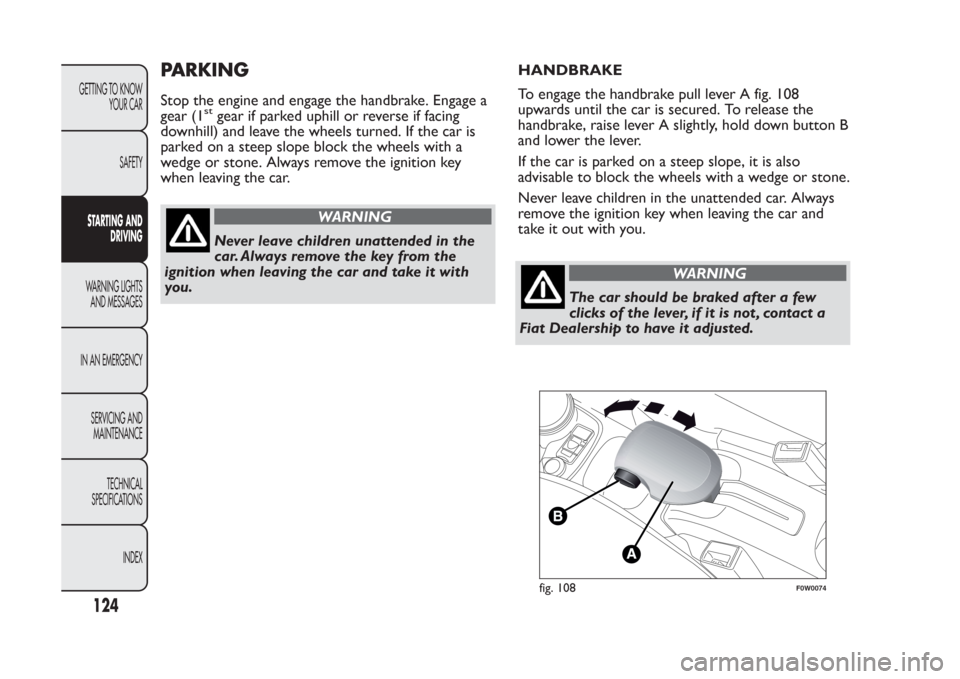
PARKINGStop the engine and engage the handbrake. Engage a
gear (1
st
gear if parked uphill or reverse if facing
downhill) and leave the wheels turned. If the car is
parked on a steep slope block the wheels with a
wedge or stone. Always remove the ignition key
when leaving the car.
WARNING
Never leave children unattended in the
car. Always remove the key from the
ignition when leaving the car and take it with
you.HANDBRAKE
To engage the handbrake pull lever A fig. 108
upwards until the car is secured. To release the
handbrake, raise lever A slightly, hold down button B
and lower the lever.
If the car is parked on a steep slope, it is also
advisable to block the wheels with a wedge or stone.
Never leave children in the unattended car. Always
remove the ignition key when leaving the car and
take it out with you.
WARNING
The car should be braked after a few
clicks of the lever, if it is not , contact a
Fiat Dealership to have it adjusted.
fig. 108
F0W0074
124
GETTING TO KNOW
YOUR CAR
SAFETYSTARTING AND
DRIVINGWARNING LIGHTS
AND MESSAGES
IN AN EMERGENCY
SERVICING AND
MAINTENANCE
TECHNICAL
SPECIFICATIONS
INDEX
Page 129 of 284
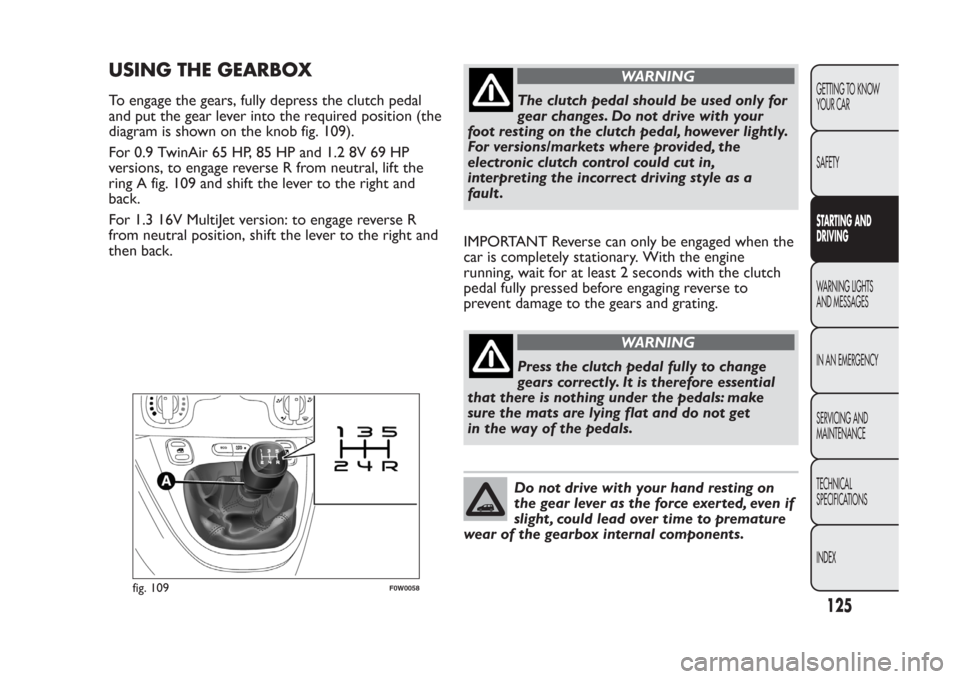
USING THE GEARBOXTo engage the gears, fully depress the clutch pedal
and put the gear lever into the required position (the
diagram is shown on the knob fig. 109).
For 0.9 TwinAir 65 HP, 85 HP and 1.2 8V 69 HP
versions, to engage reverse R from neutral, lift the
ring A fig. 109 and shift the lever to the right and
back.
For 1.3 16V MultiJet version: to engage reverse R
from neutral position, shift the lever to the right and
then back.
WARNING
The clutch pedal should be used only for
gear changes. Do not drive with your
foot resting on the clutch pedal, however lightly.
For versions/markets where provided, the
electronic clutch control could cut in,
interpreting the incorrect driving style as a
fault .
IMPORTANT Reverse can only be engaged when the
car is completely stationary. With the engine
running, wait for at least 2 seconds with the clutch
pedal fully pressed before engaging reverse to
prevent damage to the gears and grating.
WARNING
Press the clutch pedal fully to change
gears correctly. It is therefore essential
that there is nothing under the pedals: make
sure the mats are lying flat and do not get
in the way of the pedals.Do not drive with your hand resting on
the gear lever as the force exerted, even if
slight , could lead over time to premature
wear of the gearbox internal components.
fig. 109
F0W0058
125GETTING TO KNOW
YOUR CAR
SAFETYSTARTING AND
DRIVINGWARNING LIGHTS
AND MESSAGES
IN AN EMERGENCY
SERVICING AND
MAINTENANCE
TECHNICAL
SPECIFICATIONS
INDEX
Page 130 of 284
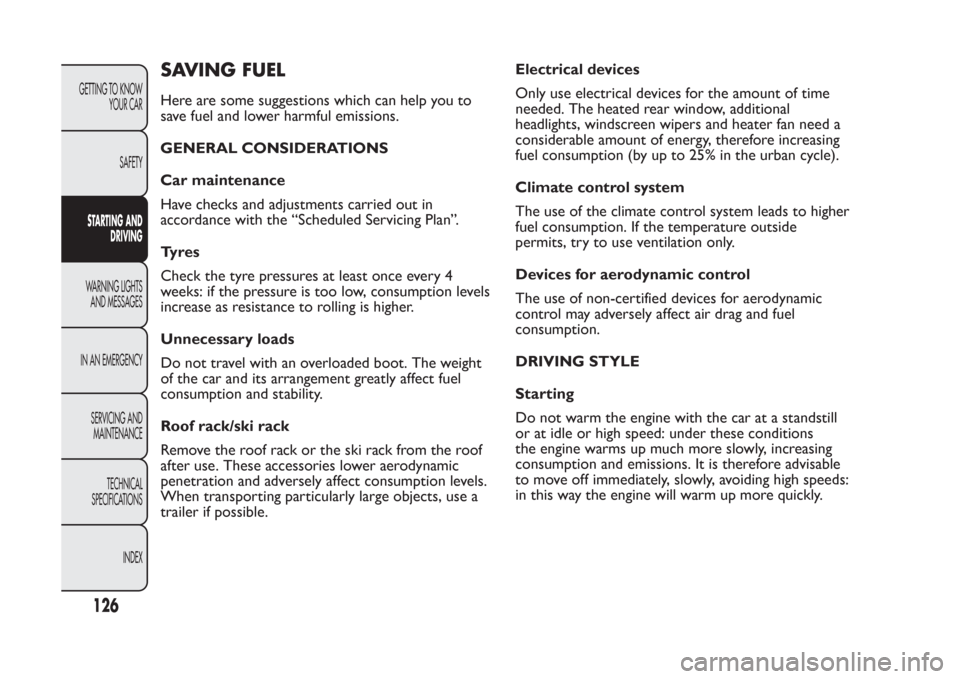
SAVING FUELHere are some suggestions which can help you to
save fuel and lower harmful emissions.
GENERAL CONSIDERATIONS
Car maintenance
Have checks and adjustments carried out in
accordance with the “Scheduled Servicing Plan”.
Ty r e s
Check the tyre pressures at least once every 4
weeks: if the pressure is too low, consumption levels
increase as resistance to rolling is higher.
Unnecessary loads
Do not travel with an overloaded boot. The weight
of the car and its arrangement greatly affect fuel
consumption and stability.
Roof rack/ski rack
Remove the roof rack or the ski rack from the roof
after use. These accessories lower aerodynamic
penetration and adversely affect consumption levels.
When transporting particularly large objects, use a
trailer if possible.Electrical devices
Only use electrical devices for the amount of time
needed. The heated rear window, additional
headlights, windscreen wipers and heater fan need a
considerable amount of energy, therefore increasing
fuel consumption (by up to 25% in the urban cycle).
Climate control system
The use of the climate control system leads to higher
fuel consumption. If the temperature outside
permits, try to use ventilation only.
Devices for aerodynamic control
The use of non-certified devices for aerodynamic
control may adversely affect air drag and fuel
consumption.
DRIVING STYLE
Starting
Do not warm the engine with the car at a standstill
or at idle or high speed: under these conditions
the engine warms up much more slowly, increasing
consumption and emissions. It is therefore advisable
to move off immediately, slowly, avoiding high speeds:
in this way the engine will warm up more quickly.
126
GETTING TO KNOW
YOUR CAR
SAFETYSTARTING AND
DRIVINGWARNING LIGHTS
AND MESSAGES
IN AN EMERGENCY
SERVICING AND
MAINTENANCE
TECHNICAL
SPECIFICATIONS
INDEX